Distinguished Critique: Doomsday Clock Review
Though certainly clever in its own right, this Watchmen "sequel" often finds itself in the shadow of its revered predecessor
—by Nathan on September 10, 2023—
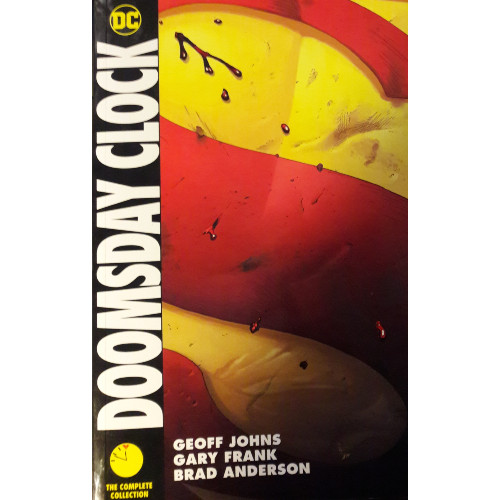
The Doomsday Clock is a symbolic representation of how close humankind is to global disaster. Created during the Cold War, the Clock encompasses a broad perspective on the state of humanity, not just regarding nuclear Armageddon. The closer the minute hand ticks towards midnight, the closer experts believe we are to global catastrophe. Since January 2023, the clock has been positioned at 90 seconds to midnight, the closest it’s been since 1947. Tick-tock, tick-tock...
Geoff Johns, DC architect and famed comic scribe, joined with artist Gary Frank (who Johns worked with on Superman: Secret Origin and Batman: Earth One) to craft a visual representation of this scenario. With the mainstream DC world already under pressure from mounting superhuman emergencies, the ticking hand of doom moves ever closer to midnight with the arrival of a certain blue deity. Dr. Manhattan has arrived on the scene, and sadly, he’s not here to perform a last-minute heroic surgery.
Doomsday Clock
Writer: Geoff Johns
Penciler: Gary Frank
Inker: Gary Frank
Colorist: Brad Anderson
Letterer: Rob Leigh
Issues: Doomsday Clock #1-12
Publication Dates: November 2017, February 2018-March 2018, May 2018, July 2018, September 2018, November 2018, February 2019, May 2019, July 2019, November 2019, February 2020
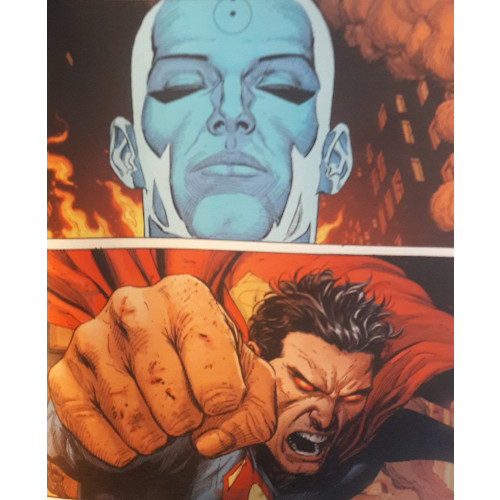
Note: save for some minor edits, this blog is the same as it was when I originally posted it to Hubpages
Similar to my confession in my Crisis on Infinite Earths review, I would like to admit my lack of understanding regarding the modern DC Universe overall. When I read Doomsday Clock, I was generally unaware of the state of DC Comics regarding the New 52 and Rebirth. I had a bit of familiarity with some stories–I've read Flashpoint and most of Scott Snyder's New 52 run on Batman (even a good chunk of Tom King's Rebirth run), but I am largely ignorant of what exactly was going on in the DC Universe during the two-years-and-change this series was published. That being said, as important as context certainly would have been going into this series, I wanted to read it more as a "Watchman sequel" than anything else.
My biggest draw to this series was in fact that: the Watchmen connections. I discussed Alan Moore and Dave Gibbons’ series at length, praising its genuinely wonderful detailed artistry and complex narrative, complaining slightly about its characters. I know fans consider Watchmen the greatest comic of all time and even the idea of a quasi-sequel or other writers and artists attached to that universe may be anathema to some readers. Generally, I appreciated Johns and Frank’s ability to draw in the Watchmen characters. They begin with a simple statement made by Dr. Manhattan at Watchmen’s end and go on from there. Their ability to pull in characters feels natural, for the most part.
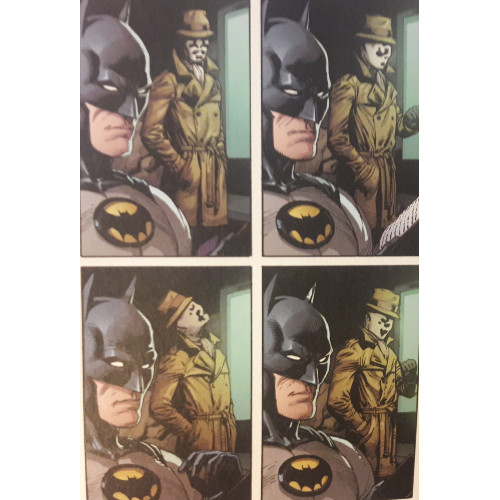
Johns envisions, not so much a Watchmen sequel, but a continuation of Moore and Gibbons’ original series. The series best moments see Johns unpack his vision of what occurs after the original series concludes. What happens to characters such as Ozymandias? How about brand new characters, like the second Rorschach, who are impacted in interesting ways by the events of Watchmen? Johns’ ability to shape a unique, detailed "epilogue" of sorts, if you’d like to call it that, crafting a brief look at the future of the Watchmen universe is entertaining and engaging.
But Johns wishes to work in new material as well, creating new characters and allowing Moore’s cast to interact with the mainstream DC Universe. His new antagonists, Mime and Marionette, are interesting characters in their own right, feeling less like a Joker/Harley Quinn rip off that I originally believed they’d end up being. They drive a small chunk of the main narrative, and Johns cleverly incorporates their origins and ongoing story into the series. Their inclusion makes for several fun sequences, and even though I can’t say they’ll ever become as recognizable as their original Watchmen counterparts (or the criminal clowns they seem inspired by), they aren’t a bad addition to the universe. Likewise, the new Rorschach has connections to a character in the original series; you might have to swallow a small convenience pill to fully grasp his inclusion (this new character is never even hinted at in the original series), but like Mime and Marionette, this Rorschach becomes integral enough to the overarching plot to forgive a couple of convenient plot points.
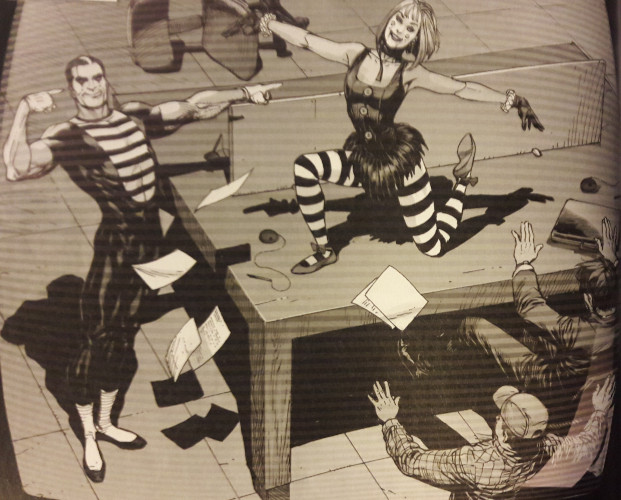
Less pardonable is the writer/artist duo’s consistent desire to pay verbal and visual homage to Moore and Gibbons’ series. Here and there, the gimmick works–Frank’s use of the nine-panel grid, copying Gibbons’ layout, evokes a visual comparison to the earlier narrative. The structure brings enough familiarity without feeling like it’s leeching off the original series. The nine-panel grid, naturally, isn’t limited to just Watchmen and Doomsday Clock, so though it’s a definite homage here, the layout design works well on its own. But Johns often mimics a wonderful running gag of sorts throughout the entire original series: the beautiful parallels between Moore’s narration and Gibbons’ artistry. Panels often juxtapose the text and art gorgeously, tethering them together and deepening the story. In Doomsday Clock, the exact same trick is used several times, to less effect.
If Johns had been merely writing his own narrative, I might have been endeared to this trick or even just excused it. As it stands, with Doomsday Clock serving as a quasi-sequel, Johns comes off as more derivative and less clever. The connections between text and art, which often feel seamless in Watchmen or at least meticulously considered by Moore, are more forced here. Connections are less clever, images feel steered more towards making the tether between random lines of dialogue than offering any deeper meaning. This isn’t to say Johns wasn’t thinking through these connections, but the gimmick often feels rushed and a little on-the-nose.
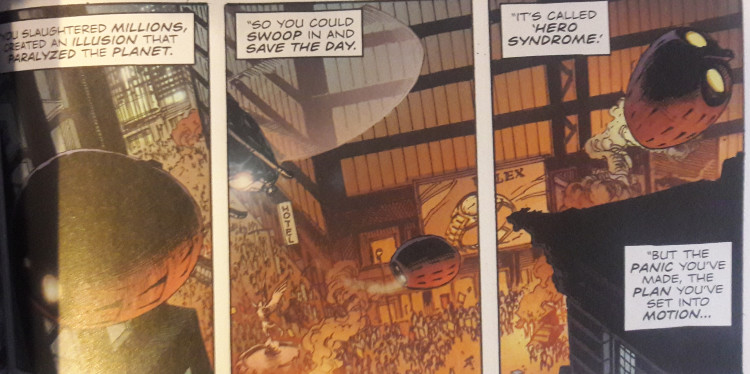
Additionally, Johns attempts to weave in a smaller tale, similar to Moore’s inclusion of the Black Freighter comics. Johns utilizes the life of a fictional movie star and his final movie, allowing the story to graft into the frame tale he provides. In Watchmen, Moore and Gibbons’ Black Freighter contained several different parallels to the overarching series, a "story within a story" which served as a metaphor for the overarching narrative. Though Doomsday Clock’s cinematic equivalent certainly connects more directly to the larger narrative, this subplot simply feels too derivative to be as impactful.
Outside the obvious Watchmen parallels, Johns is trying his best to weave an incredibly ambitious tale, and it’s here he's more successful. The story actually doesn’t need the Watchmen elements to be effective, outside of Dr. Manhattan. Johns is working to make sense of the DC Universe collectively, pulling together the various reboots (post-Crisis, New 52, and Rebirth), anchoring them to Superman, and making sense of them coherently. I found the plot point compelling, perhaps only because I had recently read arcs like Crisis on Infinite Earths, John Byrne's Man of Steel and Mark Waid’s Superman: Birthright (as well as Johns’ own Secret Origin). I couldn’t describe for the breadth of the DC Multiverse and how it all weaves together coherently, but Johns works to give the concept of the Multiverse a core structure. It’s not just "Well, we have this universe over here and that universe over there." He gives the Multiverse a genuinely interesting meaning outside of the series or outside of "writer wanted to create a new or updated version of a popular hero with lots of backstory and baggage within the main DC Universe."
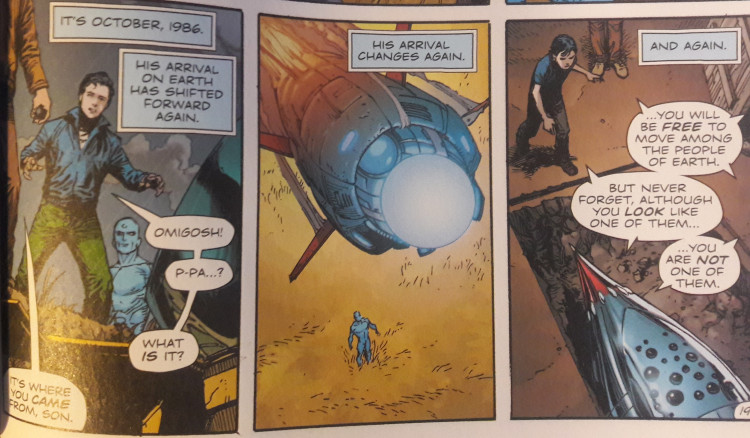
Doomsday Clock comes with a lot to unpack. It’s not necessarily the "Watchmen sequel" some may have touted it being before it was released; if we’re being honest, the Watchmen elements are iffy at best. While they’re the reason I picked up the story initially–an early scene where a seemingly alive Comedian shoots Lex Luthor after Luthor interacts with Ozymandias made me geek out royally–the adaptive elements of Moore and Gibbons’ classic can become a little pandering. Johns misuses Moore and Gibbons’ narrative parallelism and poetry, trying to be clever when he ends up being unoriginal, similar to his failure to create a genuinely gripping Superman reboot in Secret Origin.
I enjoyed Johns’ ability to continue Moore’s narrative and introduce new characters, especially as those pieces impacted the story. I never felt like Johns needed to live up to Moore’s legacy or ruined his characters by using them in a story that, overall, isn’t quite as simultaneously edgy, endearing, or clever as the original series. Where Johns falters are in his direct homages to Moore–it’s funny that, seeing how closely tied to Watchmen Johns’ Doomsday Clock is, the best aspects of Johns’ series happen when he’s not overtly connecting himself to Moore’s saga. If Johns had just pulled in the characters and crafted his own original story without feeling the need to ape Moore’s prose, Doomsday Clock may have felt more impactful and original...and, if anything, it may have given fans a welcome return to the Watchmen universe after so many years of being apart.